Antarctic Survey Telescope 3-3: Overview, System Performance and Preliminary Observations at Yaoan, Yunnan
Abstract
1. Introduction
2. Observation Hardware
2.1. The CMOS Camera
2.2. AST3-3 Observation Executor
2.3. Weather-Based Protection System
3. Basic Observation Strategy of AST3-3
3.1. Transient Survey Strategy
3.2. Automatic Follow Up Strategy
3.2.1. Gamma-Ray Bursts
3.2.2. Gravitational Waves Events
4. Data Collections
4.1. Observation Statistics of AST3-3
4.2. SN 2022eyw Detection by the Time-Domain Survey
4.3. Follow-Up Observation of Gamma-Ray Burst 210420B
5. Conclusions
Author Contributions
Funding
Institutional Review Board Statement
Informed Consent Statement
Data Availability Statement
Acknowledgments
Conflicts of Interest
Appendix A
| Resolution | Frame Rates at 16 Bit | Max Exposure Time | Magnitude Limit |
|---|---|---|---|
| Full Frame | - | 1 s | 16.59 |
| Full Frame | 2.0 FPS | 500 ms | 15.73 |
| 5374 Lines | 3.9 FPS | 500 ms | 15.73 |
| 3000 Lines | 7.2 FPS | 135 ms | 14.61 |
| 2000 Lines | 10 FPS | 100 ms | 13.63 |
| 1000 Lines | 20 FPS | 50 ms | 11.74 |
| Card Name | Typical Value | Comment |
|---|---|---|
| CAMERA | ‘QHY411MERIS’ | camera ID |
| EXPOSURE | 60 | exposure |
| MODE | 4 | read out mode |
| FILTER | ‘g’ | fixed |
| DATE-OBS | ‘2021-06-20T17:56:51.304’ | time before exposure |
| DATE-END | ‘2021-06-20T17:57:53.496’ | time after exposure |
| SKY | 923.79 | center background |
| SKYSIG | 12.206 | center background RMS |
| TEMP1 | −27.9 | CMOS temperature before exposure |
| TEMP2 | −27.0 | CMOS temperature after exposure |
| PWMSET | 255.0 | cooler PWM setting |
| COOLER | −50.0 | cooler target temperature |
| GAMMA | 1.0 | gamma value |
| OFFSET | 50.0 | offset of coms camera |
| RA | 279.752319 | target right ascension |
| DEC | 10.0 | target declination |
| ALTITUDE | 74.48 | altitude |
| AZIMUTH | 178.3 | azimuth |
| SKYIDX | ‘1839 + 1000’ | target name |
| ENCRA | ‘−0.518577’ | encoder right ascension |
| ENCDEC | ‘9.808846’ | encode declination |
| FOCPOS | ‘12.090’ | focus position |
| HA | ‘359.481423’ | hour angle of target |
References
- Price, P.A.; Magnier, E.A. Pan-STARRS PSF-Matching for Subtraction and Stacking. arXiv 2019, arXiv:1901.09999. [Google Scholar]
- Bellm, E. The Zwicky Transient Facility. In Proceedings of the Third Hot-Wiring the Transient Universe Workshop, Santa Fe, NM, USA, 13–15 November 2013; pp. 27–33. [Google Scholar]
- Bellm, E.C.; Kulkarni, S.R.; Graham, M.J.; Dekany, R.; Smith, R.M.; Riddle, R.; Masci, F.J.; Helou, G.; Prince, T.A.; Adams, S.M.; et al. The Zwicky Transient Facility: System Overview, Performance, and First Results. Publ. Astron. Soc. Pac. 2019, 131, 018002. [Google Scholar] [CrossRef]
- Tonry, J.L.; Denneau, L.; Heinze, A.N.; Stalder, B.; Smith, K.W.; Smartt, S.J.; Stubbs, C.W.; Weiland, H.J.; Rest, A. ATLAS: A High-cadence All-sky Survey System. Publ. Astron. Soc. Pac. 2018, 130, 064505. [Google Scholar] [CrossRef]
- Gompertz, B.P.; Cutter, R.; Steeghs, D.; Galloway, D.K.; Lyman, J.; Ulaczyk, K.; Dyer, M.J.; Ackley, K.; Dhillon, V.S.; O’Brien, P.T.; et al. Searching for electromagnetic counterparts to gravitational-wave merger events with the prototype Gravitational-Wave Optical Transient Observer (GOTO-4). Mon. Not. RAS 2020, 497, 726–738. [Google Scholar] [CrossRef]
- Scalzo, R.A.; Yuan, F.; Childress, M.J.; Möller, A.; Schmidt, B.P.; Tucker, B.E.; Zhang, B.R.; Onken, C.A.; Wolf, C.; Astier, P.; et al. The SkyMapper Transient Survey. Publ. Astron. Soc. Aust. 2017, 34, e030. [Google Scholar] [CrossRef]
- Becerra, R.L.; Dichiara, S.; Watson, A.M.; Troja, E.; Butler, N.R.; Pereyra, M.; Moreno Méndez, E.; De Colle, F.; Lee, W.H.; Kutyrev, A.S.; et al. DDOTI observations of gravitational-wave sources discovered in O3. Mon. Not. RAS 2021, 507, 1401–1420. [Google Scholar] [CrossRef]
- Walkowicz, L. The Large Synoptic Survey Telescope. In Proceedings of the SALT Science Conference 2015 (SSC2015), Stellenbosch Institute of Advanced Study, South Africa, 1–5 June 2015; p. 20. [Google Scholar]
- Zhang, T.M.; Wang, X.F.; Chen, J.C.; Zhang, J.J.; Zhou, L.; Li, W.X.; Liu, Q.; Mo, J.; Zhang, K.C.; Yao, X.Y.; et al. The THU-NAOC transient survey: The performance and results from the first year. Res. Astron. Astrophys. 2015, 15, 215–224. [Google Scholar] [CrossRef]
- Zhang, J.C.; Wang, X.F.; Mo, J.; Xi, G.B.; Lin, J.; Jiang, X.J.; Zhang, X.M.; Li, W.X.; Yan, S.Y.; Chen, Z.H.; et al. The Tsinghua University-Ma Huateng Telescopes for Survey: Overview and Performance of the System. Publ. Astron. Soc. Pac. 2020, 132, 125001. [Google Scholar] [CrossRef]
- Wang, X.; Zhao, H.B.; Xia, Y.; Lu, H.; Li, B. CNEOST Control Software System. Acta Astron. Sin. 2015, 56, 178–188. [Google Scholar] [CrossRef]
- Yang, X.; Shang, Z.; Hu, K.; Hu, Y.; Ma, B.; Wang, Y.; Cao, Z.; Ashley, M.C.B.; Wang, W. Cloud cover and aurora contamination at dome A in 2017 from KLCAM. Mon. Not. RAS 2021, 501, 3614–3620. [Google Scholar] [CrossRef]
- Kenyon, S.L.; Storey, J.W.V. A Review of Optical Sky Brightness and Extinction at Dome C, Antarctica. Publ. Astron. Soc. Pac. 2006, 118, 489–502. [Google Scholar] [CrossRef]
- Storey, J.W.V. Astronomy from Antarctica. Antarct. Sci. 2005, 17, 555. [Google Scholar] [CrossRef]
- Lawrence, J.S.; Ashley, M.C.B.; Burton, M.G.; Cui, X.; Everett, J.R.; Indermuehle, B.T.; Kenyon, S.L.; Luong-Van, D.; Moore, A.M.; Storey, J.W.V.; et al. Site testing Dome A, Antarctica. In Proceedings of the Ground-based and Airborne Telescopes, Orlando, FL, USA, 24–31 May 2006; Volume 6267. [Google Scholar]
- Ashley, M.C.B. Site characteristics of the high Antarctic plateau. In Proceedings of the International Astronomical Union, Nanjing, China, 24 August 2012; Volume 8. Symposium S288: Astrophysics from Antarctica. [Google Scholar] [CrossRef]
- Storey, J.W.V. Introduction to the Antarctic Plateau. Chin. Astron. Astrophys. 2007, 31, 98–100. [Google Scholar] [CrossRef]
- Shang, Z. Astronomy from Dome A in Antarctica. Res. Astron. Astrophys. 2020, 20, 168. [Google Scholar] [CrossRef]
- Zou, H.; Zhou, X. The i-band Sky brightness and Transparency at Dome A, Antarctica. arXiv 2011, arXiv:1101.2362. [Google Scholar] [CrossRef]
- Yang, Y.; Moore, A.M.; Krisciunas, K.; Wang, L.; Ashley, M.C.B.; Fu, J.; Brown, P.J.; Cui, X.; Feng, L.L.; Gong, X.; et al. Optical Sky Brightness and Transparency during the Winter Season at Dome A Antarctica from the Gattini-All-Sky Camera. Astron. J. 2017, 154, 6. [Google Scholar] [CrossRef]
- Hu, Y.; Shang, Z.; Ashley, M.C.B.; Bonner, C.S.; Hu, K.; Liu, Q.; Li, Y.; Ma, B.; Wang, L.; Wen, H. Meteorological Data for the Astronomical Site at Dome A, Antarctica. Publ. Astron. Soc. Pac. 2014, 126, 868. [Google Scholar] [CrossRef][Green Version]
- Zhou, X.; Ashley, M.C.B.; Cui, X.; Feng, L.; Gong, X.; Hu, J.; Jiang, Z.; Kulesa, C.A.; Lawrence, J.S.; Liu, G.; et al. Progress and Results from the Chinese Small Telescope ARray (CSTAR). In Proceedings of the International Astronomical Union, Nanjing, China, 24 August 2012; Volume 8. Symposium S288: Astrophysics from Antarctica. [Google Scholar] [CrossRef]
- Li, X.; Wang, D.; Xu, L.; Zhao, J.; Du, F.; Zhang, Y. Control system for the first three Antarctic Survey Telescopes (AST3-1). In Proceedings of the Ground-Based and Airborne Telescopes IV, Amsterdam, The Netherlands, 1–6 July 2012; Volume 8444. [Google Scholar]
- Li, X.; Yuan, X.; Gu, B.; Yang, S.; Li, Z.; Du, F. Chinese Antarctic Astronomical Optical Telescopes. Rev. Mex. Astron. Astrofis. Conf. Ser. 2019, 51, 135–138. [Google Scholar]
- Wang, L.; Macri, L.M.; Ma, B.; Wang, L.F.; Ashley, M.C.B.; Cui, X.; Du, F.J.; Fu, J.N.; Feng, L.L.; Gong, X.; et al. Stellar variability from Dome A, Antarctica. EPJ Web Conf. 2017, 152, 02010. [Google Scholar] [CrossRef]
- Huang, T.J.; Sun, T.R.; Hu, L.; Ning, Z.J.; Wu, X.F.; Wang, L.F.; Wang, X.F. An Automatic Method for Detecting Transients and Variable Sources in AST3 Survey Based on Image Subtraction and Random Forest. Chin. Astron. Astrophys. 2020, 44, 41–60. [Google Scholar] [CrossRef]
- Liang, E.S.; Zhang, H.; Yu, Z.; Yang, M.; Zhou, J.l.; Ashley, M.C.B.; Cui, X.; Du, F.; Fu, J.; Gong, X.; et al. Exoplanets in the Antarctic Sky. III. Stellar Flares Found by AST3-II (CHESPA) within the Southern CVZ of TESS. Astron. J. 2020, 159, 201. [Google Scholar] [CrossRef]
- Zhang, H.; Yu, Z.; Liang, E.; Yang, M.; Ashley, M.C.B.; Cui, X.; Du, F.; Fu, J.; Gong, X.; Gu, B.; et al. Exoplanets in the Antarctic Sky. I. The First Data Release of AST3-II (CHESPA) and New Found Variables within the Southern CVZ of TESS. Astrophys. J. Suppl. 2019, 240, 16. [Google Scholar] [CrossRef]
- Zhang, H.; Yu, Z.; Liang, E.; Yang, M.; Ashley, M.C.B.; Cui, X.; Du, F.; Fu, J.; Gong, X.; Gu, B.; et al. Exoplanets in the Antarctic Sky. II. 116 Transiting Exoplanet Candidates Found by AST3-II (CHESPA) within the Southern CVZ of TESS. Astrophys. J. Suppl. 2019, 240, 17. [Google Scholar] [CrossRef]
- Hu, L.; Wu, X.; Andreoni, I.; Ashley, M.C.B.; Cooke, J.; Cui, X.; Du, F.; Dai, Z.; Gu, B.; Hu, Y.; et al. Optical observations of LIGO source GW 170817 by the Antarctic Survey Telescopes at Dome A, Antarctica. Sci. Bull. 2017, 62, 1433–1438. [Google Scholar] [CrossRef]
- Andreoni, I.; Ackley, K.; Cooke, J.; Acharyya, A.; Allison, J.R.; Anderson, G.E.; Ashley, M.C.B.; Baade, D.; Bailes, M.; Bannister, K.; et al. Follow Up of GW170817 and Its Electromagnetic Counterpart by Australian-Led Observing Programmes. Publ. Astron. Soc. Aust. 2017, 34, e069. [Google Scholar] [CrossRef]
- Ma, B.; Hu, Y.; Shang, Z.; Hu, K.; Wang, Y.; Yang, X.; Ashley, M.C.B.; Yuan, X.; Wang, L. Automation of the AST3 optical sky survey from Dome A, Antarctica. Mon. Not. RAS 2020, 496, 2768–2775. [Google Scholar] [CrossRef]
- Yuan, X.; Cui, X.; Wang, L.; Gu, B.; Du, F.; Li, Z.; Yang, S.; Li, X.; Lu, H.; Wen, H.; et al. The Antarctic Survey Telescopes AST3 and the AST3-NIR. IAU Gen. Assem. 2015, 29, 2256923. [Google Scholar]
- Burton, M.G.; Zheng, J.; Mould, J.; Cooke, J.; Ireland, M.; Uddin, S.A.; Zhang, H.; Yuan, X.; Lawrence, J.; Ashley, M.C.B.; et al. Scientific Goals of the Kunlun Infrared Sky Survey (KISS). Publ. Astron. Soc. Aust. 2016, 33, e047. [Google Scholar] [CrossRef]
- Yuan, X.; Su, D.Q. Optical system of the Three Antarctic Survey Telescopes. Mon. Not. RAS 2012, 424, 23–30. [Google Scholar] [CrossRef]
- Zheng, J.R.; Churilov, V.; Content, R.; Lawrence, J.; Gu, B.; Lu, H.; Wen, H.; Yuan, X. Optical system design of the AST3-NIR camera. In Proceedings of the Ground-Based and Airborne Instrumentation for Astronomy VII, Austin, TX, USA, 10–15 June 2018. [Google Scholar]
- Farr, B.; LIGO Scientific Collaboration; Virgo Collaboration. The Latest Results from the LIGO-Virgo O3 Observing Run. In Proceedings of the American Astronomical Society Meeting Abstracts #235, Honolulu, HI, USA, 4–8 January 2020; Volume 235, p. 119.02. [Google Scholar]
- Zhang, C.; Ping, Y.; Zhao, C. CHES: A Rapid All-Sky Survey System for SSA. In Proceedings of the The Advanced Maui Optical and Space Surveillance Technologies Conference, Wailea, Maui, HI, USA, 11–14 September 2018. [Google Scholar]
- Castro-Tirado, A.J. Robotic Astronomy and the BOOTES Network of Robotic Telescopes. Acta Polytech. 2011, 51, 16. [Google Scholar] [CrossRef]
- Boer, M.; Klotz, A.; Atteia, J.L.; Buchholtz, G.; Daigne, F.; Eysseric, J.; Goldoni, P.; Jean, P.; Lecavelier Des Etangs, A.; Lopez, M.; et al. The Gamma-Ray Burst Hunt at La Silla the TAROT-S Very Fast Moving Telescope. Messenger 2003, 113, 45–48. [Google Scholar]
- Watson, A.M.; Cuevas Cardona, S.; Alvarez Nuñez, L.C.; Ángeles, F.; Becerra-Godínez, R.L.; Chapa, O.; Farah, A.S.; Fuentes-Fernández, J.; Figueroa, L.; Langarica Lebre, R.; et al. COATLI: An all-sky robotic optical imager with 0.3 arcsec image quality. In Proceedings of the Ground-Based and Airborne Instrumentation for Astronomy VI, Edinburgh, UK, 26 June–1 July 2016. [Google Scholar]
- Becerra, R.L.; Watson, A.M.; Fraija, N.; Butler, N.R.; Lee, W.H.; Troja, E.; Román-Zúñiga, C.G.; Kutyrev, A.S.; Álvarez Nuñez, L.C.; Ángeles, F.; et al. Late Central-engine Activity in GRB 180205A. Astrophys. J. 2019, 872, 118. [Google Scholar] [CrossRef]
- Lipunov, V.M.; Krylov, A.V.; Kornilov, V.G.; Borisov, G.V.; Kuvshinov, D.A.; Belinsky, A.A.; Kuznetsov, M.V.; Potanin, S.A.; Antipov, G.A.; Tyurina, N.V.; et al. MASTER: The Mobile Astronomical System of Telescope-Robots. Astron. Nachr. 2004, 325, 580–582. [Google Scholar] [CrossRef]
- Yuan, Y.; Li, F.; Fu, Y.; Ren, S. New precise positions in 2013–2019 and a catalog of ground-based astrometric observations of 11 Neptunian satellites (1847–2019) based on Gaia-DR2. Astron. Astrophys. 2021, 645, A48. [Google Scholar] [CrossRef]
- Flewelling, H. Pan-STARRS Data Release 1. In Proceedings of the American Astronomical Society Meeting Abstracts #229, Grapevine, TX, USA, 3–7 January 2017; Volume 229, p. 237. [Google Scholar]
- Abazajian, K.N.; Adelman-McCarthy, J.K.; Agüeros, M.A.; Allam, S.S.; Allende Prieto, C.; An, D.; Anderson, K.S.J.; Anderson, S.F.; Annis, J.; Bahcall, N.A.; et al. The Seventh Data Release of the Sloan Digital Sky Survey. Astrophys. J. Suppl. 2009, 182, 543–558. [Google Scholar] [CrossRef]
- Rhodes, B. Skyfield: High Precision Research-Grade Positions for Planets and Earth Satellites Generator. Available online: http://ascl.net/1907.024 (accessed on 21 May 2022).
- Greenfield, P.; Robitaille, T.; Tollerud, E.; Aldcroft, T.; Barbary, K.; Barrett, P.; Bray, E.; Crighton, N.; Conley, A.; Conseil, S.; et al. Astropy: Community Python Library for Astronomy. Available online: http://ascl.net/1304.002 (accessed on 21 May 2022).
- Barbary, K. SEP: Source Extractor as a library. J. Open Source Softw. 2016, 1, 58. [Google Scholar] [CrossRef]
- Warren, W.H.J.; Hoffleit, D. The Bright Star Catalogue, 5th ed. Available online: https://ui.adsabs.harvard.edu/abs/1987BAAS...19..733W/abstract (accessed on 21 May 2022).
- Schlegel, D.J.; Finkbeiner, D.P.; Davis, M. Maps of Dust Infrared Emission for Use in Estimation of Reddening and Cosmic Microwave Background Radiation Foregrounds. Astrophys. J. 1998, 500, 525–553. [Google Scholar] [CrossRef]
- Scoville, N.; Aussel, H.; Brusa, M.; Capak, P.; Carollo, C.M.; Elvis, M.; Giavalisco, M.; Guzzo, L.; Hasinger, G.; Impey, C.; et al. The Cosmic Evolution Survey (COSMOS): Overview. Astrophys. J. Suppl. 2007, 172, 1–8. [Google Scholar] [CrossRef]
- Giavalisco, M.; Ferguson, H.C.; Koekemoer, A.M.; Dickinson, M.; Alexander, D.M.; Bauer, F.E.; Bergeron, J.; Biagetti, C.; Brandt, W.N.; Casertano, S.; et al. The Great Observatories Origins Deep Survey: Initial Results from Optical and Near-Infrared Imaging. Astrophys. J. Lett. 2004, 600, L93–L98. [Google Scholar] [CrossRef]
- Liske, J.; Baldry, I.K.; Driver, S.P.; Tuffs, R.J.; Alpaslan, M.; Andrae, E.; Brough, S.; Cluver, M.E.; Grootes, M.W.; Gunawardhana, M.L.P.; et al. Galaxy And Mass Assembly (GAMA): End of survey report and data release 2. Mon. Not. RAS 2015, 452, 2087–2126. [Google Scholar] [CrossRef]
- Oliver, S.; Rowan-Robinson, M.; Alexander, D.M.; Almaini, O.; Balcells, M.; Baker, A.C.; Barcons, X.; Barden, M.; Bellas-Velidis, I.; Cabrera-Guerra, F.; et al. The European Large Area ISO Survey—I. Goals, definition and observations. Mon. Not. RAS 2000, 316, 749–767. [Google Scholar] [CrossRef]
- Aihara, H.; AlSayyad, Y.; Ando, M.; Armstrong, R.; Bosch, J.; Egami, E.; Furusawa, H.; Furusawa, J.; Harasawa, S.; Harikane, Y.; et al. Third data release of the Hyper Suprime-Cam Subaru Strategic Program. Publ. Astron. Soc. Jpn. 2022, 74, 247–272. [Google Scholar] [CrossRef]
- Sömen, O.; Emeç, S.; Yilmaz, M.; Akkaya, G. An Overview of Chinese Postman Problem. In Proceedings of the 3rd International Conference on Advanced Engineering Technologies, Duhok, Kurdistan Region-Iraq, 2–4 April 2019. [Google Scholar]
- Barthelmy, S. GCN and VOEvent: A status report. Astron. Nachr. 2008, 329, 340. [Google Scholar] [CrossRef]
- Kaspi, V.M.; CHIME/FRB Collaboration. The CHIME Fast Radio Burst Project. In Proceedings of the American Astronomical Society Meeting Abstracts #229, Grapevine, TX, USA, 3–7 January 2017; Volume 229, p. 242. [Google Scholar]
- Swinbank, J.D.; Allan, A.; Denny, R.B. VOEvent Transport Protocol Version 2.0. IVOA Recommendation 20 March 2017. Available online: https://ui.adsabs.harvard.edu/abs/2017ivoa.spec.0320S/abstract (accessed on 21 May 2022).
- Gal-Yam, A. The TNS Alert System. Available online: https://baas.aas.org/pub/2021n1i423p05 (accessed on 21 May 2022).
- Rutledge, R.E. The Astronomer’s Telegram: A Web-based Short-Notice Publication System for the Professional Astronomical Community. Publ. Astron. Soc. Pac. 1998, 110, 754–756. [Google Scholar] [CrossRef]
- Moss, M.J.; Evans, P.A.; Gronwall, C.; Gropp, J.D.; Kennea, J.A.; Page, K.L.; Sbarufatti, B.; Neil Gehrels Swift Observatory Team. GRB 210420B: Swift detection of a burst. GRB Coord. Netw. 2021, 29844, 1. [Google Scholar]
- Meegan, C.; Lichti, G.; Bhat, P.N.; Bissaldi, E.; Briggs, M.S.; Connaughton, V.; Diehl, R.; Fishman, G.; Greiner, J.; Hoover, A.S.; et al. The Fermi Gamma-ray Burst Monitor. Astrophys. J. 2009, 702, 791–804. [Google Scholar] [CrossRef]
- Atwood, W.B.; Abdo, A.A.; Ackermann, M.; Althouse, W.; Anderson, B.; Axelsson, M.; Baldini, L.; Ballet, J.; Band, D.L.; Barbiellini, G.; et al. The Large Area Telescope on the Fermi Gamma-Ray Space Telescope Mission. Astrophys. J. 2009, 697, 1071–1102. [Google Scholar] [CrossRef]
- Li, Y.; Wen, X.; Sun, X.; Liu, X.; Liang, X.; Guo, D.; Peng, W.; Gong, K.; Li, G.; Wang, H.; et al. The GECAM and its payload. Sci. Sin. Phys. Mech. Astron. 2020, 50, 129508. [Google Scholar] [CrossRef]
- Clark, B.A.; Clark, B.A.; IceCube-Gen2 Collaboration. The IceCube-Gen2 Neutrino Observatory. J. Instrum. 2021, 16, C10007. [Google Scholar] [CrossRef]
- Fermi GBM Team. GRB 220321A: Fermi GBM Final Localization. GRB Coord. Netw. 2022, 31777, 1. [Google Scholar]
- Singer, L.P.; Price, L.R. Rapid Bayesian position reconstruction for gravitational-wave transients. Phys. Rev. D 2016, 93, 024013. [Google Scholar] [CrossRef]
- Veitch, J.; Raymond, V.; Farr, B.; Farr, W.; Graff, P.; Vitale, S.; Aylott, B.; Blackburn, K.; Christensen, N.; Coughlin, M.; et al. Parameter estimation for compact binaries with ground-based gravitational-wave observations using the LALInference software library. Phys. Rev. D 2015, 91, 042003. [Google Scholar] [CrossRef]
- Górski, K.M.; Hivon, E.; Banday, A.J.; Wandelt, B.D.; Hansen, F.K.; Reinecke, M.; Bartelmann, M. HEALPix: A Framework for High-Resolution Discretization and Fast Analysis of Data Distributed on the Sphere. Astrophys. J. 2005, 622, 759–771. [Google Scholar] [CrossRef]
- Singer, L.P.; Chen, H.Y.; Holz, D.E.; Farr, W.M.; Price, L.R.; Raymond, V.; Cenko, S.B.; Gehrels, N.; Cannizzo, J.; Kasliwal, M.M.; et al. Going the Distance: Mapping Host Galaxies of LIGO and Virgo Sources in Three Dimensions Using Local Cosmography and Targeted Follow-up. Astrophys. J. Lett. 2016, 829, L15. [Google Scholar] [CrossRef]
- Singer, L.P.; Chen, H.Y.; Holz, D.E.; Farr, W.M.; Price, L.R.; Raymond, V.; Cenko, S.B.; Gehrels, N.; Cannizzo, J.; Kasliwal, M.M.; et al. Supplement: “Going the Distance: Mapping Host Galaxies of LIGO and Virgo Sources in Three Dimensions Using Local Cosmography and Targeted Follow-up” (2016, ApJL, 829, L15). Astrophys. J. Suppl. 2016, 226, 10. [Google Scholar] [CrossRef]
- Berger, E. Short-Duration Gamma-Ray Bursts. Annu. Rev. Astron. Astrophys. 2014, 52, 43–105. [Google Scholar] [CrossRef]
- Arcavi, I.; McCully, C.; Hosseinzadeh, G.; Howell, D.A.; Vasylyev, S.; Poznanski, D.; Zaltzman, M.; Maoz, D.; Singer, L.; Valenti, S.; et al. Optical Follow-up of Gravitational-wave Events with Las Cumbres Observatory. Astrophys. J. Lett. 2017, 848, L33. [Google Scholar] [CrossRef]
- Fan, X.; Messenger, C.; Heng, I.S. A Bayesian Approach to Multi-messenger Astronomy: Identification of Gravitational-wave Host Galaxies. Astrophys. J. 2014, 795, 43. [Google Scholar] [CrossRef]
- Fan, X.; Messenger, C.; Heng, I.S. Enhancing Gravitational Wave Astronomy with Galaxy Catalogues. In Gravitational Wave Astrophysics; Springer: Cham, Switzerland, 2015; Volume 40, p. 35. [Google Scholar] [CrossRef]
- Dálya, G.; Galgóczi, G.; Dobos, L.; Frei, Z.; Heng, I.S.; Macas, R.; Messenger, C.; Raffai, P.; de Souza, R.S. GLADE: A galaxy catalogue for multimessenger searches in the advanced gravitational-wave detector era. Mon. Not. RAS 2018, 479, 2374–2381. [Google Scholar] [CrossRef]
- Dálya, G.; Díaz, R.; Bouchet, F.R.; Frei, Z.; Jasche, J.; Lavaux, G.; Macas, R.; Mukherjee, S.; Pálfi, M.; de Souza, R.S.; et al. GLADE+: An Extended Galaxy Catalogue for Multimessenger Searches with Advanced Gravitational-wave Detectors. arXiv 2021, arXiv:2110.06184. [Google Scholar] [CrossRef]
- Hu, L.; Wang, L.; Chen, X. Image Subtraction in Fourier Space. arXiv 2021, arXiv:2109.09334. [Google Scholar]
- Bertin, E.; Arnouts, S. SExtractor: Software for source extraction. Astron. Astrophys. Suppl. 1996, 117, 393–404. [Google Scholar] [CrossRef]
- Sokolovsky, K.V.; Lebedev, A.A. VaST: A variability search toolkit. Astron. Comput. 2018, 22, 28–47. [Google Scholar] [CrossRef]
- Bertin, E. SWarp: Resampling and Co-Adding FITS Images Together. 2010. Available online: http://ascl.net/1010.068 (accessed on 21 May 2022).
- Chambers, K.C.; Boer, T.D.; Bulger, J.; Fairlamb, J.; Huber, M.; Lin, C.C.; Lowe, T.; Magnier, E.; Schultz, A.; Wainscoat, R.J.; et al. Pan-STARRS Transient Discovery Report for 2022-03-23. Available online: https://www.wis-tns.org/ads/TNSTR-2022-762 (accessed on 21 May 2022).
- Tagchi, K.; Namekata, K.; Kawabata, M.; Nakaoka, T.; Yamanaka, M. Transient Classification Report for 2022-03-25. Available online: https://ui.adsabs.harvard.edu/abs/2022TNSCR.783....1T/abstract (accessed on 21 May 2022).
- Balcon, C. Transient Classification Report for 2022-03-26. Available online: https://ui.adsabs.harvard.edu/abs/2022TNSCR.792....1B/abstract (accessed on 21 May 2022).
- Fulton, M.; Srivastav, S.; Smartt, S.J.; Smith, K.W.; Young, D.R.; Sim, S.A.; Gillanders, J.; Moore, T. QUB Transient Classification Report for 2022-03-31. Available online: https://www.wis-tns.org/ads/TNSCR-2022-833 (accessed on 21 May 2022).
- Stamatikos, M.; Barthelmy, S.D.; Cummings, J.R.; Krimm, H.A.; Laha, S.; Lien, A.Y.; Markwardt, C.B.; Palmer, D.M.; Sakamoto, T.; Ukwatta, T.N. GRB 210420B: Swift-BAT refined analysis. GRB Coord. Netw. 2021, 29879, 1. [Google Scholar]
- Osborne, J.P.; Capalbi, M.; Perri, M.; D’Elia, V.; Gropp, J.D.; Kennea, J.A.; Tohuvavohu, A.; Page, K.L.; Beardmore, A.P.; Moss, M.J.; et al. GRB 210420B: Swift-XRT refined Analysis. GRB Coord. Netw. 2021, 29876, 1. [Google Scholar]
- Uhm, Z.L.; Zhang, B. Dynamics and Afterglow Light Curves of Gamma-Ray Burst Blast Waves Encountering a Density Bump or Void. Astrophys. J. 2014, 789, 39. [Google Scholar] [CrossRef]
- Geng, J.J.; Wu, X.F.; Li, L.; Huang, Y.F.; Dai, Z.G. Revisiting the Emission from Relativistic Blast Waves in a Density-jump Medium. Astrophys. J. 2014, 792, 31. [Google Scholar] [CrossRef]
- Sari, R.; Piran, T.; Narayan, R. Spectra and Light Curves of Gamma-Ray Burst Afterglows. Astrophys. J. Lett. 1998, 497, L17–L20. [Google Scholar] [CrossRef]
- Geng, J.J.; Wu, X.F.; Huang, Y.F.; Yu, Y.B. Delayed Energy Injection Model for Gamma-Ray Burst Afterglows. Astrophys. J. 2013, 779, 28. [Google Scholar] [CrossRef]
- Geng, J.J.; Wu, X.F.; Huang, Y.F.; Li, L.; Dai, Z.G. Imprints of Electron-Positron Winds on the Multiwavelength Afterglows of Gamma-ray Bursts. Astrophys. J. 2016, 825, 107. [Google Scholar] [CrossRef]
- Lien, A.Y.; Moss, M.J.; Tohuvavohu, A.; Neil Gehrels Swift Observatory Team. GRB 210420B: Update on the BAT trigger time. GRB Coord. Netw. 2021, 29854, 1. [Google Scholar]
- Lipunov, V.; Kornilov, V.; Gorbovskoy, E.; Chasovnikov, A.; Balanutsa, P.; Vladimirov, V.; Kuznetsov, A.; Vlasenko, D.; Tiurina, N.; Gorbunov, I.; et al. GRB 210420B: MASTER optical counterpart detection. GRB Coord. Netw. 2021, 29845, 1. [Google Scholar]
- Oksanen, A. GRB 210420B: Optical observations. GRB Coord. Netw. 2021, 29846, 1. [Google Scholar]
- Hu, Y.D.; Sun, T.R.; Fernandez-Garcia, E.; Castro-Tirado, A.J.; Caballero-Garcia, M.D.; Castro Tirado, M.A.; Perez del Pulgar, C.; Castellon, A.; Carrasco, I.; Guziy, S.; et al. GRB 210420B: BOOTES-4/MET optical afterglow detection. GRB Coord. Netw. 2021, 29847, 1. [Google Scholar]
- Mommert, M.; Moskovitz, N.; Trilling, D.E. PHOTOMETRYPIPELINE—An Automated Pipeline for Calibrated Photometry. In Proceedings of the AAS/Division for Planetary Sciences Meeting, Pasadena, CA, USA, 16–21 October 2016. [Google Scholar]
- Leonini, S.; Conti, M.; Rosi, P.; Tinjaca Ramirez, L.M. GRB 210420B: Montarrenti Observatory optical afterglow detection. GRB Coord. Netw. 2021, 29851, 1. [Google Scholar]
- de Ugarte Postigo, A.; Malesani, D.B.; Knudstrup, E. GRB 210420B: Multiband photometry from NOT. GRB Coord. Netw. 2021, 29852, 1. [Google Scholar]
- Astropy Collaboration; Robitaille, T.P.; Tollerud, E.J.; Greenfield, P.; Droettboom, M.; Bray, E.; Aldcroft, T.; Davis, M.; Ginsburg, A.; Price-Whelan, A.M.; et al. Astropy: A community Python package for astronomy. Astron. Astrophys. 2013, 558, A33. [Google Scholar] [CrossRef]
- Astropy Collaboration; Price-Whelan, A.M.; Sipőcz, B.M.; Günther, H.M.; Lim, P.L.; Crawford, S.M.; Conseil, S.; Shupe, D.L.; Craig, M.W.; Dencheva, N.; et al. The Astropy Project: Building an Open-science Project and Status of the v2.0 Core Package. Astron. J. 2018, 156, 123. [Google Scholar] [CrossRef]
- Rhodes, B.C. PyEphem: Astronomical Ephemeris for Python. Available online: http://ascl.net/1112.014 (accessed on 21 May 2022).
- Hunter, J.D. Matplotlib: A 2D Graphics Environment. Comput. Sci. Eng. 2007, 9, 90–95. [Google Scholar] [CrossRef]
- Jones, E.; Oliphant, T.; Peterson, P. SciPy: Open Source Scientific Tools for Python. 2001. Available online: https://scipy.org/ (accessed on 21 May 2022).
- Seabold, S.; Perktold, J. Statsmodels: Econometric and statistical modeling with python. In Proceedings of the 9th Python in Science Conference, Austin, TX, USA, 28 June–3 July 2010. [Google Scholar]
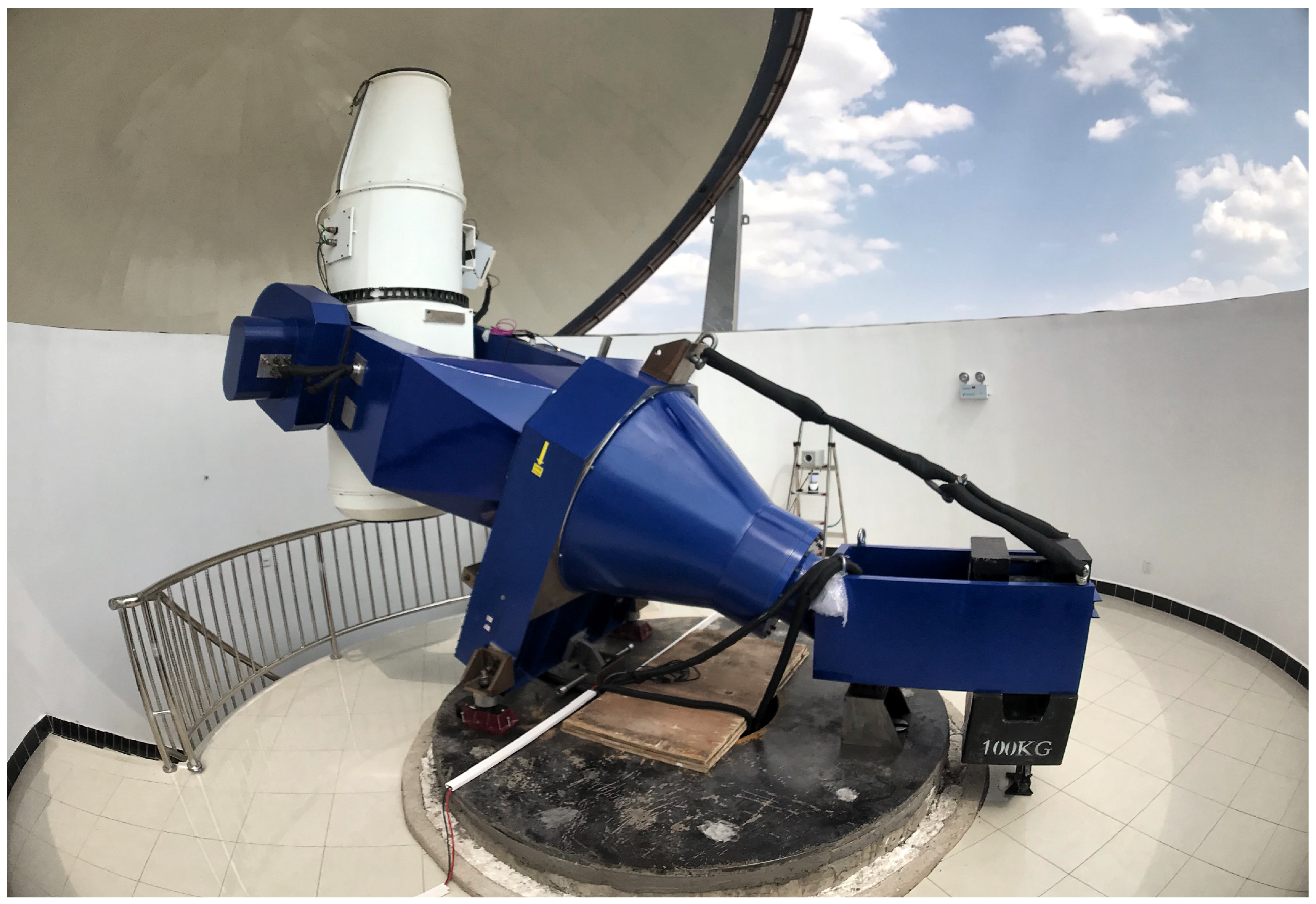
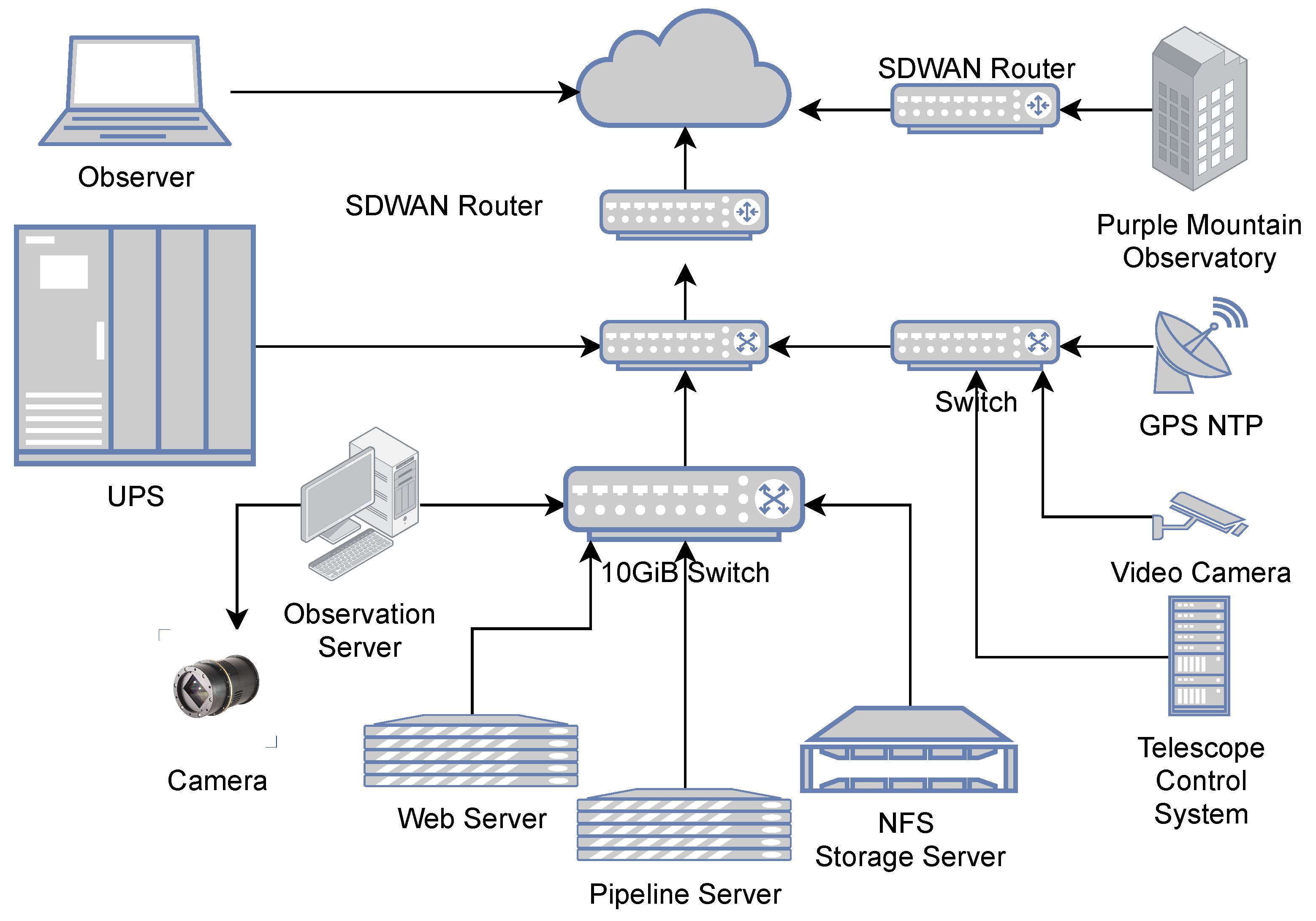
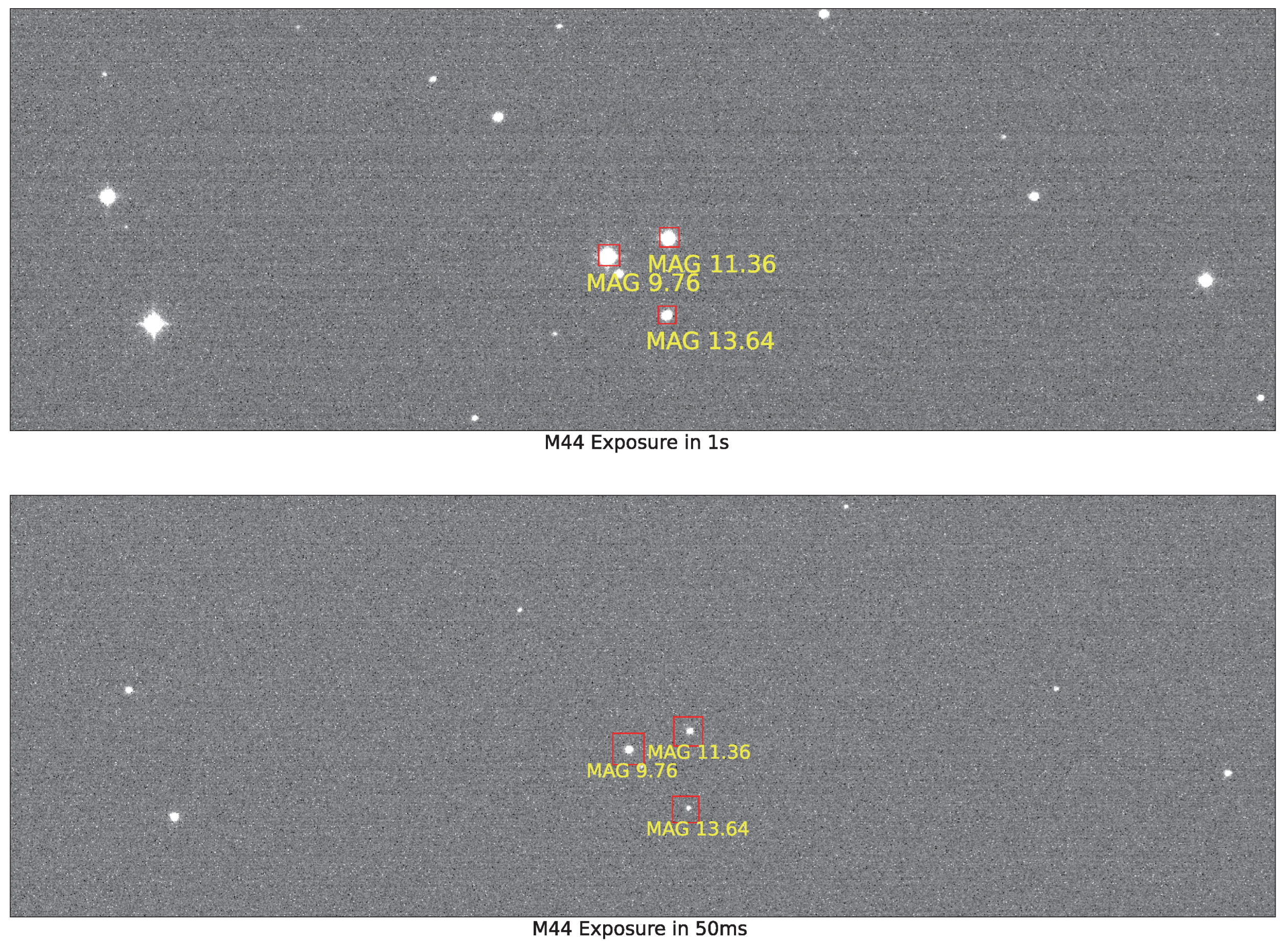
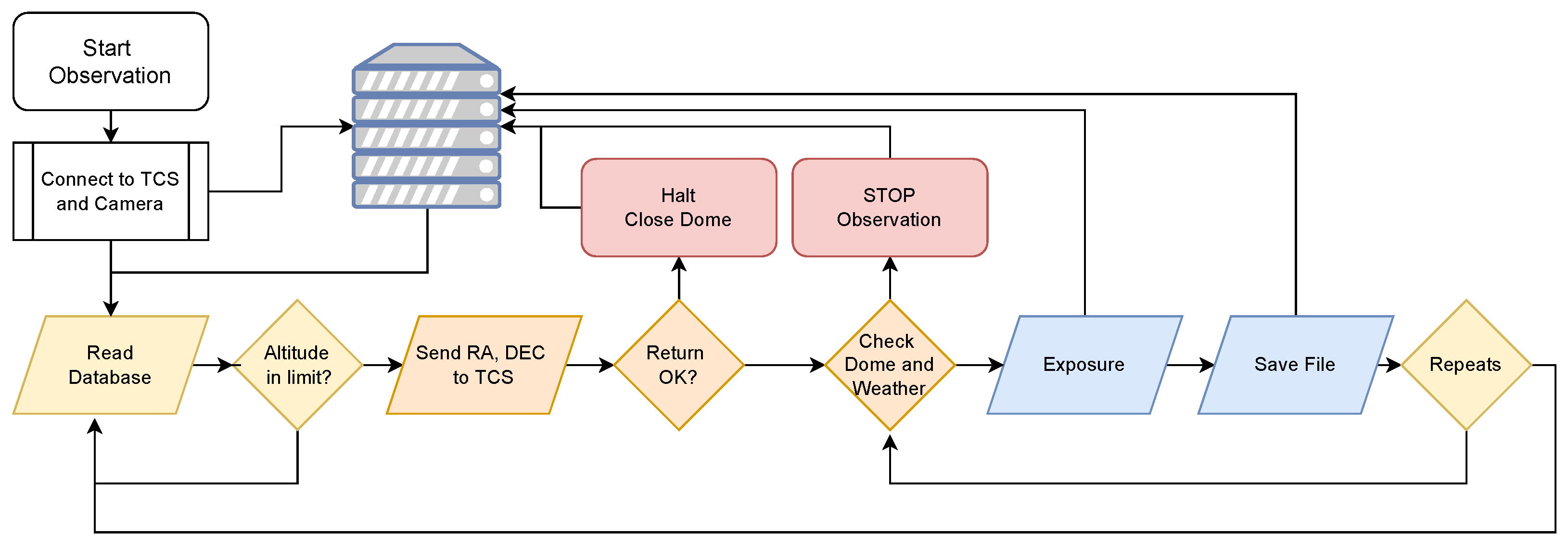



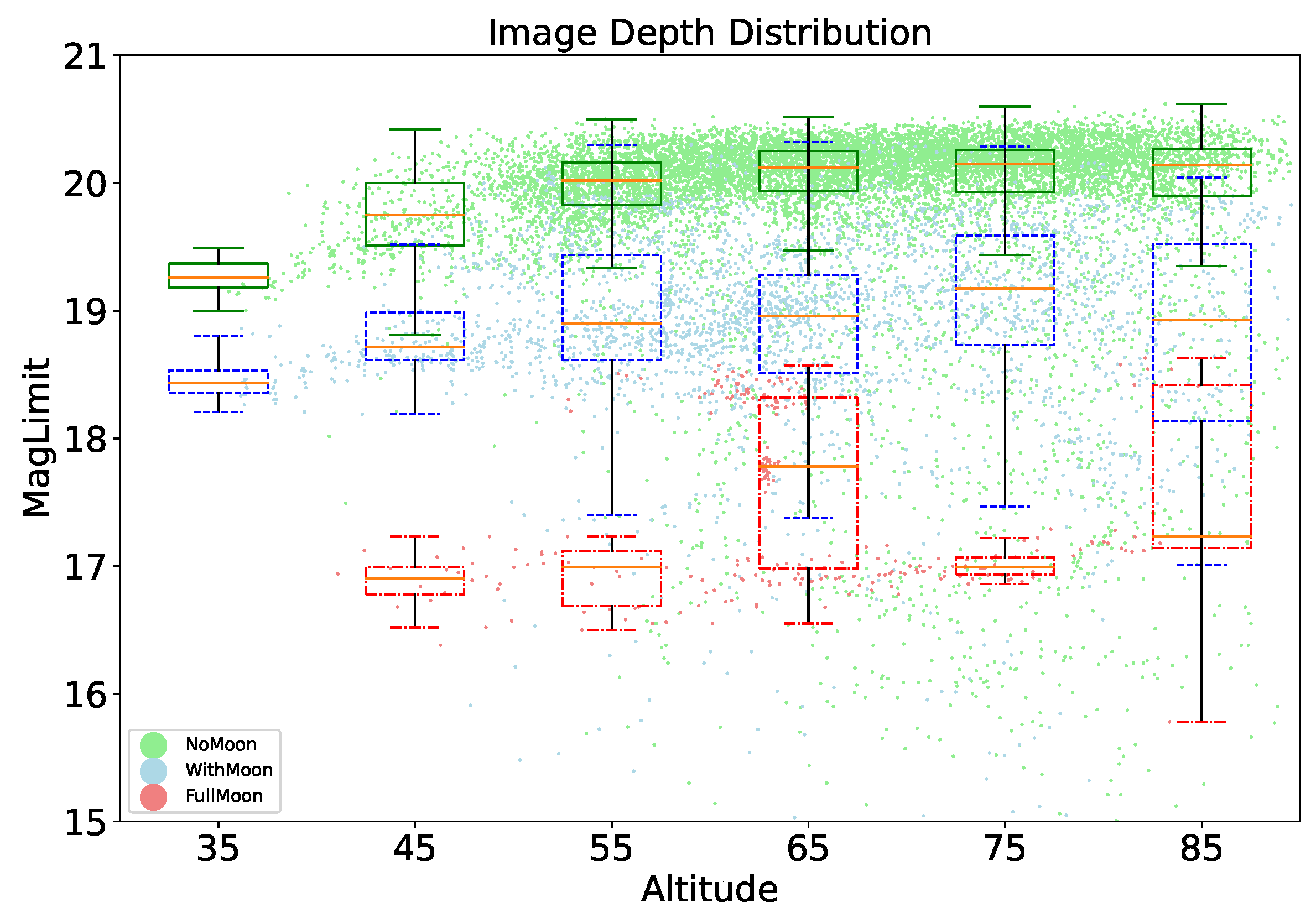





| SeverID | Job | Type | CPU and Accelerator | Memory |
|---|---|---|---|---|
| 1 | Observation | R7525 | AMD 7252 × 2 + FPGA | 128 GiB |
| 2 | Pipeline | R7525 | AMD 7522 × 2 + A100 × 2 | 512 GiB |
| 3 | (NFS) Storage | R740xd2 | 4214R | 128 GiB |
| 4 | Asteroid | R740xd2 | 5118 | 256 GiB |
| 5 | Web | D30 | E5-2620 | 32 GiB |
| Name | R.A. | Dec. | Pointings |
|---|---|---|---|
| GAMA_G02 | 30.2∼38.8 | −10.25∼−3.72 | 33 |
| GAMA_G09 | 129.0∼141.0 | −2∼+3 | 13 |
| GAMA_G12 | 174.0∼186.0 | −3∼+2 | 26 |
| GAMA_G15 | 211.5∼223.5 | −2∼+3 | 11 |
| GAMA_G23 | 339.0∼351.0 | −35∼−30 | 57 |
| GOODS_N | 189.2291 | 62.2375 | 8 |
| COSMOS | +150.1191 | +2.20583 | 4 |
| Virgo_Cluster | 186.75 | 12.71 | 38 |
| ELAIS_N1 | 242.5041 | 54.51 | 1 |
| AEGIS | 213∼217 | 51.75∼54.00 | 4 |
| HSC_SSP | - | - | 609 |
| Packet Type | Name | Priority | RadiusErr | Pointings | Repeats | Exposure Time |
|---|---|---|---|---|---|---|
| 53 | INTEGRAL_WAKEUP | 140 | 10 | 1 | 30 | 60 s |
| 54 | INTEGRAL_REFINED | 141 | 5 | 1 | 30 | 30 s |
| 55 | INTEGRAL_OFFLINE | 142 | 3∼5 | 1 | 60 | 60 s |
| 61 | SWIFT_BAT_GRB_POS_ACK | 131 | 1-5 | 1 | 30 | 30 s |
| 65 | SWIFT_FOM_OBS | 132 | 10 | 1 | 60 | 30 s |
| 67 | SWIFT_XRT_POSITION | 134 | 5 | 1 | 60 | 60 s |
| 69 | SWIFT_XRT_IMAGE | 135 | 5 | 1 | 60 | 60 s |
| 81 | SWIFT_UVOT_POS | 137 | 2 | 1 | 60 | 60 s |
| 84 | SWIFT_BAT_TRANS | 133 | 10 | 1 | 60 | 60 s |
| 110 | FERMI_GBM_ALERT | 100 | 4∼ | ∼20 | 5 | 30 s |
| 111 | FERMI_GBM_FLT_POS | 101 | 4∼ | ∼20 | 5 | 30 s |
| 112 | FERMI_GBM_GND_POS | 102 | 4∼ | ∼40 | 5 | 60 s |
| 115 | FERMI_GBM_FIN_POS | 103 | 4∼ | ∼40 | 5 | 60 s |
| 120 | FERMI_LAT_POS_INI | 110 | 10–30 | 1 | 30 | 60 s |
| 121 | FERMI_LAT_POS_UPD | 111 | 10–30 | 1 | 60 | 60 s |
| 127 | FERMI_LAT_GND | 112 | 10 | 1 | 60 | 60 s |
| 173 | ICECUBE_ASTROTRACK_GOLD | 121 | 0.2–0.75 | 1∼2 | 10 | 60 s |
| 174 | ICECUBE_ASTROTRACK_BRONZE | 120 | 0.2–0.75 | 1∼2 | 10 | 60 s |
| - | GECAM_FLIGHT_NOTIC | 105 | 2∼ | ∼20 | 5 | 60 s |
| - | GECAM GND-BDS | 106 | 1∼ | ∼40 | 5 | 60 s |
Publisher’s Note: MDPI stays neutral with regard to jurisdictional claims in published maps and institutional affiliations. |
© 2022 by the authors. Licensee MDPI, Basel, Switzerland. This article is an open access article distributed under the terms and conditions of the Creative Commons Attribution (CC BY) license (https://creativecommons.org/licenses/by/4.0/).
Share and Cite
Sun, T.; Li, X.; Hu, L.; Meng, K.; Han, Z.; Hu, M.; Li, Z.; Wen, H.; Du, F.; Yang, S.; et al. Antarctic Survey Telescope 3-3: Overview, System Performance and Preliminary Observations at Yaoan, Yunnan. Universe 2022, 8, 303. https://doi.org/10.3390/universe8060303
Sun T, Li X, Hu L, Meng K, Han Z, Hu M, Li Z, Wen H, Du F, Yang S, et al. Antarctic Survey Telescope 3-3: Overview, System Performance and Preliminary Observations at Yaoan, Yunnan. Universe. 2022; 8(6):303. https://doi.org/10.3390/universe8060303
Chicago/Turabian StyleSun, Tianrui, Xiaoyan Li, Lei Hu, Kelai Meng, Zijian Han, Maokai Hu, Zhengyang Li, Haikun Wen, Fujia Du, Shihai Yang, and et al. 2022. "Antarctic Survey Telescope 3-3: Overview, System Performance and Preliminary Observations at Yaoan, Yunnan" Universe 8, no. 6: 303. https://doi.org/10.3390/universe8060303
APA StyleSun, T., Li, X., Hu, L., Meng, K., Han, Z., Hu, M., Li, Z., Wen, H., Du, F., Yang, S., Gu, B., Yuan, X., Li, Y., Wang, H., Liu, L., Zhu, Z., Huang, X., Lei, C., Wang, L., & Wu, X. (2022). Antarctic Survey Telescope 3-3: Overview, System Performance and Preliminary Observations at Yaoan, Yunnan. Universe, 8(6), 303. https://doi.org/10.3390/universe8060303






